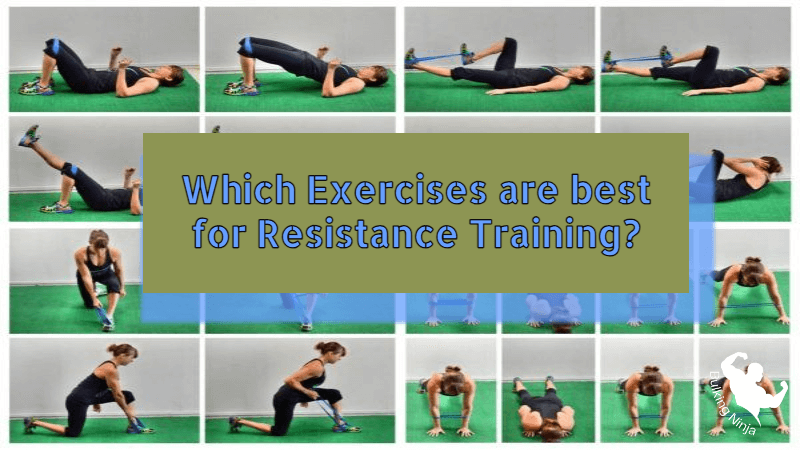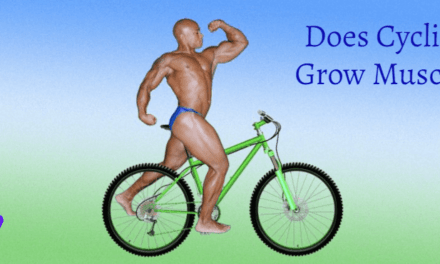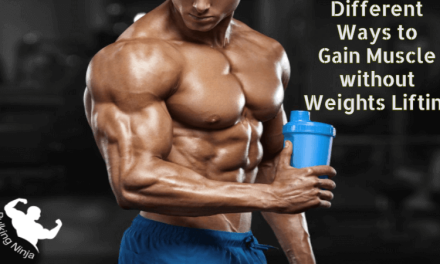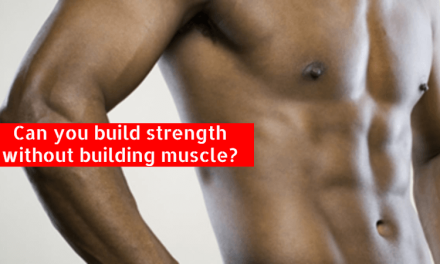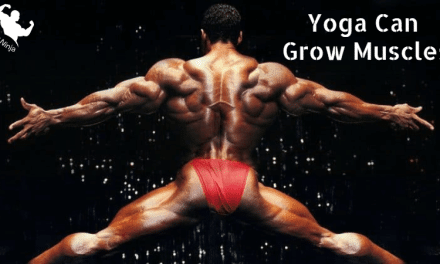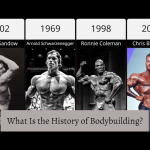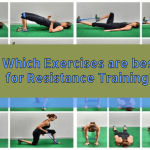Resistance training, a cornerstone of fitness regimes worldwide, is lauded for its ability to build strength, enhance muscle tone, and improve overall health. But with a plethora of exercises available, it’s often a conundrum to determine which ones reign supreme in the realm of resistance training.
In this blog post, we’ll dive into the world of resistance workouts, exploring a variety of exercises that exercises are best for resistance training and deemed the best for maximizing results. From classic free-weight moves to innovative machine-based routines, we’ll guide you through the top picks that cater to both beginners and seasoned fitness enthusiasts, ensuring your time in the gym is both efficient and effective.
Whether your goal is to build muscle, increase endurance, or simply get stronger, these exercises stand as the pillars of an impactful resistance training program.
Table of Contents
Which Exercises are best for Resistance Training?
The “best” resistance exercise depends on individual fitness goals, preferences, and physical condition. However, some universally recognized effective exercises include:
Squats
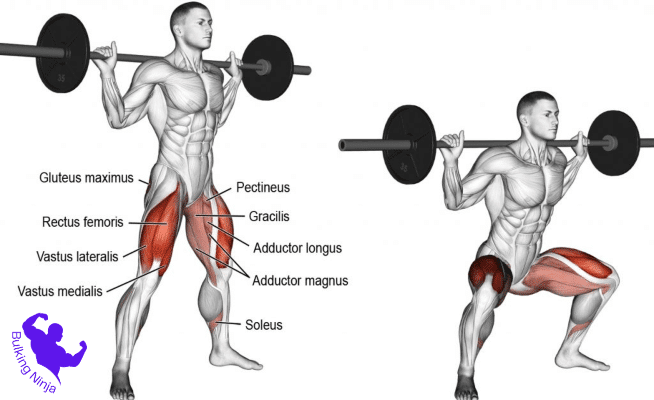
Squats are an essential exercise in any strength training regimen, particularly for enhancing lower body strength and conditioning. At their core, squats are a compound movement, meaning they engage multiple muscle groups simultaneously, which leads to more effective and efficient workouts. Here’s a closer look at their benefits and variations:
-
Primary Muscle Targets
- Quadriceps Located at the front of the thigh, the quadriceps are heavily worked during the squatting motion.
- Hamstrings These muscles at the back of the thigh provide balance and power during the exercise.
- Glutes Squats are renowned for their effectiveness in strengthening the gluteal muscles.
- Calves While not the primary focus, the calf muscles also play a role in the movement.
-
Core Engagement
- Beyond the lower body, squats require significant core engagement. The abdominal and lower back muscles work to stabilize the body throughout the movement, enhancing core strength and stability.
-
Types of Squats
- Back Squats: Involve placing the weight (typically a barbell) on the upper back. This variation primarily targets the glutes and lower back.
- Front Squats: Here, the weight is held at the front of the body, near the chest. This position places more emphasis on the quadriceps and upper back.
- Sumo Squats: With a wider stance and toes pointed outward, sumo squats target the inner thighs and glutes more intensely.
-
Benefits of Squats
- Lower Body Strength Regularly performing squats can lead to significant improvements in lower body strength.
- Enhanced Mobility Squats help in improving the flexibility and range of motion in the hips, knees, and ankles.
- Functional Fitness They mimic natural movement patterns, enhancing the ability to perform everyday activities with ease and reducing the risk of injury.
In summary, squats are a powerhouse exercise for developing lower body strength, engaging core muscles for stability, and offering variations to target different muscle groups. Their role in improving mobility and functional fitness makes them a foundational element in resistance training.
Deadlifts
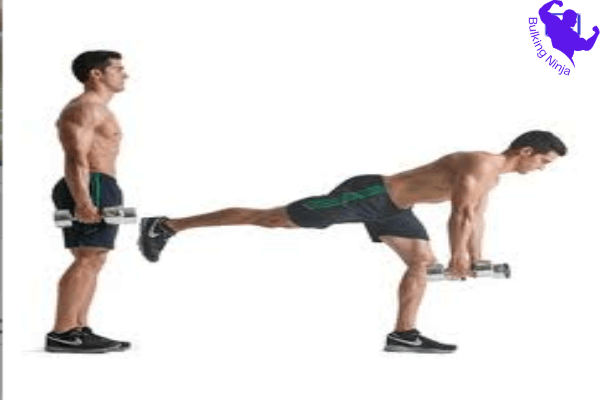
The deadlift is a highly effective exercise that targets several key muscle groups, making it a cornerstone for building overall strength. Its impact on multiple areas of the body simultaneously makes it a favorite in strength and conditioning programs. Here’s an overview of its benefits and variations:
-
Muscle Groups Engaged
- Back Deadlifts intensely work the muscles of the upper and lower back, including the latissimus dorsi, rhomboids, and spinal erectors, which are essential for back strength and posture.
- Glutes The exercise effectively targets the gluteal muscles, which are key for powerful hip extension.
- Hamstrings Located at the back of the thighs, the hamstrings are crucially engaged in the lifting phase, providing strength and stability.
- Core The core muscles, including the abdominals and obliques, are engaged to stabilize the torso throughout the movement.
-
Variations of Deadlifts
- Conventional Deadlifts This standard form involves a narrower stance with the hands placed outside the legs. It provides a balanced workout of the back, hamstrings, and glutes.
- Sumo Deadlifts Characterized by a wider stance and hands placed inside the legs, sumo deadlifts put more emphasis on the glutes and inner thighs, while still engaging the back and hamstrings.
-
Benefits of Deadlifts
- Posterior Chain Development Deadlifts are essential for developing the posterior chain, which includes the muscles on the backside of the body. This is crucial not just for athletic performance but also for everyday functional movements like lifting and bending.
- Overall Strength By engaging multiple muscle groups, deadlifts contribute to comprehensive body strength, beneficial for various physical activities and sports.
- Functional Movement Deadlifting mimics natural movement patterns, such as picking up objects from the ground, making it a practical exercise for enhancing functional fitness.
In short words, the deadlift is a versatile and powerful exercise that strengthens multiple major muscle groups, particularly those in the posterior chain. Its variations allow for targeting specific muscles differently, making it a versatile component of strength training routines. Whether you’re an athlete or someone looking to enhance overall physical strength, incorporating deadlifts into your workout regimen can yield significant benefits.
Bench Press
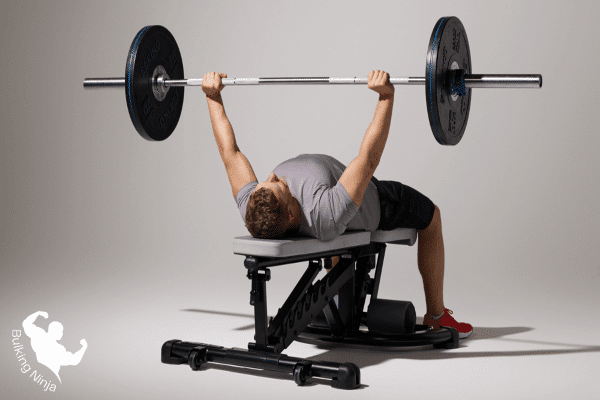
The bench press is a fundamental exercise in strength training, particularly renowned for its efficacy in building upper body strength. This exercise primarily focuses on several major muscle groups:
-
Primary Muscle Targets
- Chest (Pectoral Muscles) The bench press predominantly works the pectoralis major, the large muscle group in the chest, responsible for the pushing motion.
- Shoulders (Deltoids) The anterior (front) deltoids are significantly engaged during the bench press, assisting in lifting the weight.
- Triceps Located at the back of the upper arms, the triceps are crucial for extending the elbows during the press.
-
Execution and Equipment
- The exercise can be performed using a barbell or dumbbells, each offering slightly different benefits. Barbells allow for lifting heavier weights, while dumbbells require more stabilization, engaging additional muscle fibers.
- It is typically done on a flat bench, but variations can alter the angle of the bench to target different muscle areas.
-
Variations of Bench Press
- Incline Bench Press Performed on an inclined bench, this variation places more emphasis on the upper chest (clavicular head of the pectoralis major) and shoulders.
- Decline Bench Press The decline angle targets more of the lower chest (sternal head of the pectoralis major).
-
Benefits of Bench Press
- Upper Body Mass and Strength Regularly performing the bench press contributes to increased muscle mass and strength in the upper body, essential for both aesthetic and functional purposes.
- Versatility for Muscle Targeting The different variations of the bench press allow for comprehensive development of the chest muscles, ensuring balanced muscle growth.
In essence, the bench press is a cornerstone exercise for anyone looking to enhance upper body strength and muscle mass. Its ability to target key muscle groups effectively, along with the versatility offered by its variations, makes it a staple in weight training routines. Whether your goal is to increase strength, build muscle, or improve athletic performance, the bench press is an exercise that can yield significant results.
Pull-Ups / Chin-Ups
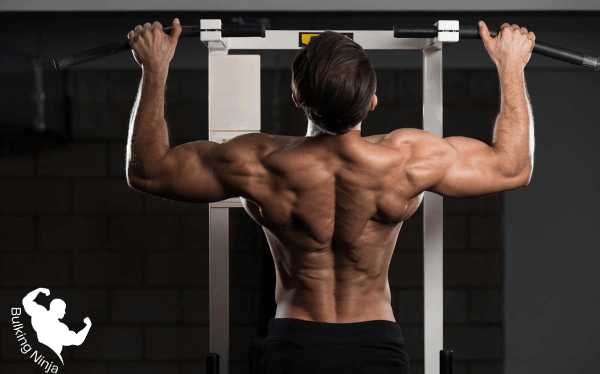
Pull-ups and chin-ups are highly effective exercises for strengthening the upper body, especially focusing on the back muscles and biceps. Here’s a detailed look at their benefits and differences:
-
Muscle Engagement
- Back Muscles Both exercises primarily target the muscles in the back, including the latissimus dorsi (lats), which are the broadest muscles of the back. Engaging these muscles contributes to a strong, well-defined back.
- Biceps The biceps brachii in the front of the upper arms are significantly worked during these exercises, especially in chin-ups due to the underhand grip.
- Core Strength Pull-ups and chin-ups also engage the core muscles, including the abdominals, which are essential for stabilizing the body during the exercise.
- Grip Strength Performing these exercises improves grip strength, as they require holding and pulling up the body weight.
-
Grip Differences
- Pull-Ups Typically performed with an overhand grip (palms facing away from the body), pull-ups more strongly engage the lats and upper back muscles.
- Chin-Ups Using an underhand grip (palms facing towards the body), chin-ups place more emphasis on the biceps, along with the back muscles.
-
Benefits of Pull-ups and chin-ups
- Upper Body Strength Both exercises are excellent for building strength in the upper body, contributing to functional fitness and improved athletic performance.
- Muscle Definition Regular practice of pull-ups and chin-ups leads to more defined back muscles and biceps, which are desirable for physical aesthetics.
- Versatility These exercises can be performed almost anywhere with a bar, making them convenient for various settings, from gyms to home workouts.
In summary, pull-ups and chin-ups are versatile and effective exercises for developing upper body strength, particularly in the back and biceps. The difference in grip between the two exercises allows for slight variations in muscle focus, making them complementary workouts for a well-rounded upper body training routine. Their ability to also enhance core and grip strength adds to their overall value in a fitness program.
Lunges
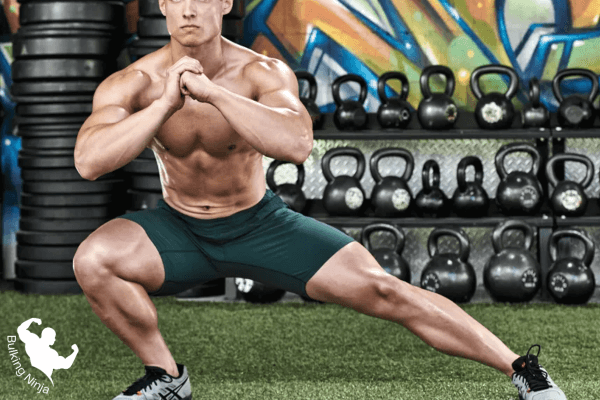
Lunges are a highly effective and versatile exercise for the lower body, offering several benefits and variations:
-
Muscle Engagement
- Quadriceps The muscles at the front of the thigh are primarily engaged during lunges, especially as you lower your body down.
- Hamstrings Located at the back of the thigh, the hamstrings work in conjunction with the quadriceps for movement control.
- Glutes Lunges are excellent for targeting the gluteal muscles, contributing to stronger and more toned buttocks.
-
Balance and Coordination
- Performing lunges requires and subsequently improves balance and coordination. This is due to the unilateral (one-sided) nature of the exercise, which challenges your stability.
-
Variations
- Stationary Lunges: These are performed in place, stepping forward or backward with one leg, then returning to the starting position.
- Walking Lunges: This dynamic variation involves stepping forward continuously, alternating legs as if walking.
- Directional Changes: Lunges can be performed forward, backward, or sideways. Each direction targets slightly different muscle groups and challenges balance in unique ways. For example, side lunges (also known as lateral lunges) are particularly good for engaging the inner and outer thigh muscles.
-
Benefits
- Lower Body Strength Lunges are excellent for building strength in the legs and glutes.
- Flexibility They also help improve flexibility in the hips, which is beneficial for overall lower body mobility.
- Functional Fitness Lunges mimic everyday movements, enhancing functional fitness and reducing the risk of injuries in daily activities.
In summary, lunges are a multifaceted exercise that not only strengthens the quadriceps, hamstrings, and glutes but also enhances balance, coordination, and flexibility. Their various forms, including walking and directional lunges, allow for a comprehensive lower body workout that can be tailored to different fitness levels and goals.
Push-Ups
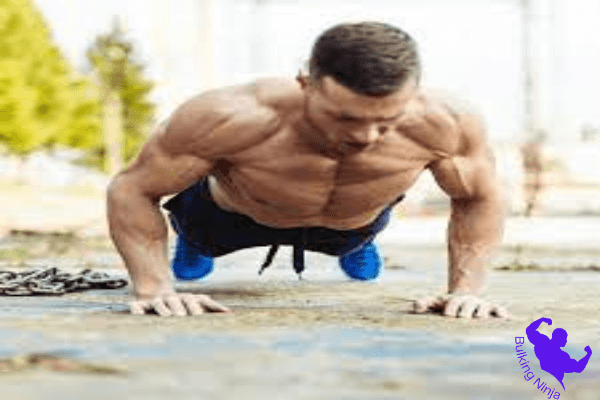
Push-ups are a fundamental bodyweight exercise that effectively strengthens various upper body muscle groups. Here’s an overview of their benefits and adaptability:
-
Muscle Engagement
- Chest (Pectoral Muscles) Push-ups primarily work the chest muscles, making them an effective exercise for building chest strength and endurance.
- Shoulders (Deltoids) The shoulder muscles are actively engaged during push-ups, particularly in stabilizing the upper body.
- Triceps The triceps, located at the back of the upper arms, are crucial for the pushing motion in this exercise.
- Core Push-ups also involve the core muscles, including the abdominals and lower back, which are essential for maintaining proper form and stability.
-
Modifications for Fitness Levels and Goals
- Wide Grip Push-ups By placing the hands wider than shoulder-width apart, the focus shifts more towards the chest muscles.
- Close Grip/Diamond Push-ups Bringing the hands closer together, or forming a diamond shape with the fingers, increases the emphasis on the triceps.
- These modifications allow individuals to tailor the exercise to their specific fitness levels and target muscle development goals.
-
Benefits
- Upper Body Endurance Regular practice of push-ups builds endurance in the chest, shoulders, and arms.
- Versatility They can be performed almost anywhere, requiring no equipment, making them a highly accessible exercise.
- Functional Strength Push-ups enhance functional upper body strength, beneficial for daily activities.
Incorporating push-ups, along with other key exercises like squats, deadlifts, lunges, and pull-ups/chin-ups, into a workout routine offers a comprehensive approach to improving strength, muscle tone, and overall fitness. Each exercise brings unique benefits and can be adjusted to suit different fitness levels, ensuring a well-rounded and effective training program.
Frequently Asked Questions
What is the best resistance training program?
The best resistance training program is personalized, typically involving 3-5 days of training per week with a variety of compound and isolation exercises. It emphasizes progressive overload, targets all major muscle groups evenly, and includes sufficient rest and sleep. The program should adapt in intensity and volume over time, be aligned with personal goals, supported by proper nutrition, maintained consistently, and ideally, developed with professional guidance, particularly for beginners or those with specific objectives.
How do I improve my resistance?
To improve your resistance in training, focus on:
- Progressive Overload: Gradually increase weights or reps over time.
- Consistency: Maintain a regular workout schedule.
- Exercise Variety: Change exercises and routines to target different muscle groups.
- Balanced Diet: Ensure adequate protein and overall nutrition.
- Rest and Recovery: Allow adequate rest between workouts for muscle growth.
- Proper Technique: Focus on form to prevent injuries.
- Compound Exercises: Include multi-muscle group exercises like squats and deadlifts.
- Cardio Fitness: Incorporate cardiovascular exercises for overall endurance.
- Track Progress: Monitor your workouts to identify improvements.
Balanced training, nutrition, and recovery are key for building and improving strength and endurance.
What resistance training should I do?
For resistance training:
- General Fitness: Focus on compound movements and bodyweight exercises.
- Muscle Building: Higher volume with varied exercises for each muscle group.
- Weight Loss: Circuit training with higher reps at lower weights.
- Beginners: Start with basic exercises, gradually increase weight.
- Specific Goals: Tailor exercises to your sport or activity.
- Include Yoga or Pilates: For flexibility and balance.
- Ensure Safety: Practice proper form and technique.
What is an example of a resisted exercise?
An example of a resisted exercise is the squat with a barbell. In this exercise, you perform a standard squat while holding a barbell across your upper back. This adds resistance to the movement, thereby engaging and strengthening the quadriceps, hamstrings, glutes, lower back, and core muscles more effectively than a bodyweight squat.
What are the three types of resistance exercise?
The three main types of resistance exercise are isometric, involving muscle contractions against a non-moving object (like planks), isotonic, which includes movements through a range of motion (such as squats and bench presses), and isokinetic, performed with machines that maintain a constant speed for consistent muscle contraction, commonly used in rehabilitation.
Is resistance a type of exercise?
Yes, resistance training is a type of exercise. It involves exercises that cause the muscles to contract against an external resistance with the expectation of increases in strength, tone, mass, and/or endurance. This resistance can come from weights, dumbbells, resistance bands, or body weight.
Conclusion
In conclusion, the best exercises for resistance training depend on individual goals, but typically include a combination of compound movements like squats, deadlifts, and bench presses, along with isolation exercises for targeted muscle development.
Incorporating a variety of exercises ensures a balanced and comprehensive approach to strengthening and toning the body. Whether you’re a beginner or an experienced fitness enthusiast, the key to success in resistance training lies in consistency, proper form, and gradually increasing the intensity of your workouts.
By integrating these effective exercises into your routine, you can build strength, improve muscle tone, and enhance overall fitness, paving the way for a healthier, more active lifestyle.
